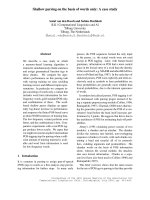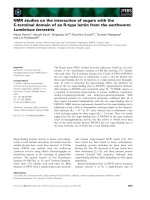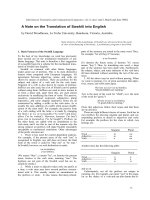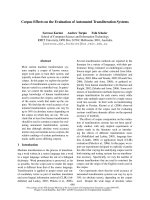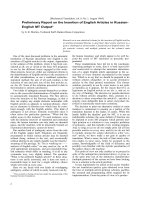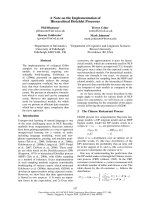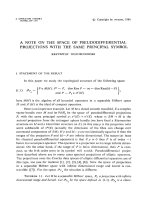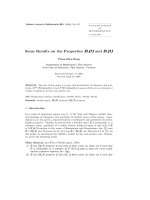Báo cáo toán học: "Improved bounds on the length of maximal abelian square-free word" pot
Bạn đang xem bản rút gọn của tài liệu. Xem và tải ngay bản đầy đủ của tài liệu tại đây (124.96 KB, 12 trang )
Improved bounds on the length of maximal abelian
square-free words
Evan M. Bullock
∗
Department of Mathematics
Rice University, Houston, Texas, USA
Submitted: Sep 28, 2003; Accepted: Feb 9, 2004; Published: Feb 20, 2004
MR Subject Classifications: 68R15, 05D99
Abstract
A word is abelian square-free if it does not contain two adjacent subwords which
are permutations of each other. Over an alphabet Σ
k
on k letters, an abelian square-
free word is maximal if it cannot be extended to the left or right by letters from
Σ
k
and remain abelian square-free. Michael Korn proved that the length (k)of
a shortest maximal abelian square-free word satisfies 4k − 7 ≤ (k) ≤ 6k − 10 for
k ≥ 6. In this paper, we refine Korn’s methods to show that 6k−29 ≤ (k) ≤ 6k−12
for k ≥ 8.
1 Introduction
We consider words over an alphabet of k letters, which will be taken to be Σ
k
= {0, 1, , k−
1}.Wesayb is a subword of d if d is the concatenation abc,wherea and c are words,
possibly empty. An abelian square is a word of the form
a
1
a
2
···a
n
a
τ(1)
a
τ(2)
···a
τ(n)
,
where the a
i
are letters and τ is a permutation of {1, n}.Awordisabelian square-free
if it does not contain a nonempty subword which is an abelian square. For example, any
word in which the same letter appears twice in a row is not abelian square-free.
Awordw over Σ
k
is left-maximal if, for every a ∈ Σ
k
,thewordaw contains an abelian
square subword beginning with the initial a. In particular, an abelian square-free word
w is left-maximal over Σ
k
if aw contains an abelian square for every a ∈ Σ
k
. Similarly,
awordw is right-maximal over Σ
k
if for every a ∈ Σ
k
, wa contains an abelian square
∗
26 Greenough St., Newton, MA 02465
the electronic journal of combinatorics 11 (2004), #R17 1
subword ending with the final a.Awordismaximal over Σ if it is both left-maximal and
right-maximal.
Abelian square-free words were first introduced by Erd˝os [4], who asked for a charac-
terization of alphabet sizes for which arbitrary long abelian square-free words exist (see
[5], [8], and [6]). Maximal abelian square-free words were first constructed by Zimin [9],
who gave the following recursive construction: z
1
=0andz
k
= z
k−1
(k − 1)z
k−1
for k>1.
The first four Zimin words are
z
1
=0,
z
2
= 010,
z
3
= 0102010,
z
4
= 010201030102010.
It is easy to check that z
k
is maximal abelian square-free over Σ
k
and that the length
of z
k
is 2
k
− 1. Thus for any positive integer k, we may define (k) to be the minimum
length of a maximal abelian square-free word over Σ
k
. Zimin’s construction shows that
(k) ≤ 2
k
− 1. Cummings and Mays [2] gave a construction improving Zimin’s bound
to (k)=O(2
k/2
). Recently, Korn [7] constructed maximal abelian square-free words of
length 6k − 10 over Σ
k
for k ≥ 4, a dramatic improvement over previous constructions.
The first four words of Korn’s construction are the following:
y
4
= 02120213202320,
y
5
= 02312302132430234230,
y
6
= 02341234021324354023452340,
y
7
= 02345123450213243546502345623450.
In Section 2, we will describe a similar construction which is shorter by two, improving
the upper bound on (k)to6k − 12.
Korn also proved that any left-maximal word over Σ
k
has length at least 4k − 7. In
fact, for left-maximal words this bound is optimal; taking the first 4k −7 letters of Korn’s
construction yields a left-maximal abelian square-free word. In Section 3, we will use
left-maximality and right-maximality together to show that (k) ≥ 6k − 29.
For more details on the history of abelian square-free words, see [7].
2 The upper bound for (k)
In this section, we will construct maximal abelian square-free words of length 6k −12 over
Σ
k
for k ≥ 8, proving the following theorem.
Theorem 2.1. For k ≥ 8, the upper bound (k) ≤ 6k − 12 holds.
For integers a and b with 0 ≤ a ≤ b<k,letu
a,b
denote a(a +1)···(b − 1)b,the
concatenation of the integers from a to b in ascending order. For integers a and b with
the electronic journal of combinatorics 11 (2004), #R17 2
1 ≤ a ≤ b<k,letv
a,b
denote a(a − 1)(a +1)a ···(b − 1)(b − 2)b(b − 1), the concatenation
in ascending order of a block i(i − 1) for each i with a ≤ i ≤ b. We are now ready to
present our construction. For k ≥ 8, set
x
k
=0v
1,k−4
(k − 3)(k − 1)(k − 4)(k − 2)u
3,k−2
0(k − 1)u
1,k−4
1302v
4,k−1
(k − 1)
The first three words x
k
are the following:
x
8
= 010213243574634560712341302435465767,
x
9
= 010213243546857345670812345130243546576878,
x
10
= 010213243546579683456780912345613024354657687989.
We note that the words x
k
are symmetric in the sense that reversing x
k
produces the
same result as replacing every appearance of i with k − 1 − i. Also, it is easy to check
that the length of x
k
is 6k − 12. Thus to prove Theorem 2.1, it will suffice to prove the
following:
Lemma 2.2. For k ≥ 8, the word x
k
is left-maximal and abelian square-free.
Proof. First, we show that x
k
is left-maximal. When the letters 0, 1, and 2 are added to
the left of x
k
, they are contained in abelian squares 00, 1010, and 201021, respectively.
When 3 is added to the left of x
k
, the two subwords
30v
1,k−4
(k − 3)(k − 1)(k − 4)(k − 2)
and
u
3,k−2
0(k − 1)u
1,k−4
1302
are consecutive and each contains the letters k − 1, k − 2, and k − 3 exactly one time, the
letter 3 exactly three times, and every other letter exactly two times. Thus together they
form an abelian square, s
3
=30···u
1,k−4
1302.
Adding the first pair from the v
4,k−1
block, namely 43, to the right side of s
3
increases
its length by two. This shifts the half-way point to the right by one, moving the initial 3
in the u
3,k−2
blockfromtherighthalftotheleft,foranetadditionofa3tothelefthalf
and a 4 to the right half. Thus if we also change the letter initially added to the left of
x
k
from a 3 to a 4, we get another abelian square, s
4
=40···u
1,k−4
130243. Continuing
in this way, we find that when i>3 is added to the left of x
k
, it is included in an abelian
square whose first half is
i0v
1,k−4
(k − 3)(k − 1)(k − 4)(k − 2)u
3,i−1
and whose second half is
u
i,k−2
0(k − 1)u
1,k−4
1302v
4,i
.
Finally, we show that x
k
is abelian square-free. First, we note that any non-empty
subword of 0v
1,k−4
contains an odd number of occurrences of some letter. In particular,
it contains exactly one occurrence of the greatest letter it contains, since between two
the electronic journal of combinatorics 11 (2004), #R17 3
occurrences of i there is always an i + 1. This shows that no subwords of 0v
1,k−4
are
abelian squares. It shows also that no subwords of x
k
starting within 0v
1,k−4
and ending
at the end of x
k
are abelian squares, since every letter occurs an even number of times in
x
k
. By symmetry, the same holds for v
4,k−1
(k − 1).
Now, suppose w is a non-empty abelian square subword of x
k
. If we delete every
instance of some letter from w, then the result is an abelian square since the same number
of occurrences of the given letter must have been deleted from the left half of w as from
the right. The resulting abelian square is a subword, possibly empty, of the word obtained
from x
k
by deleting every occurrence of the same letter. Now, if we delete from x
k
every
letter besides the first three and the last three in the alphabet, for all k, the resulting
word is
y = 010212
¯
2
¯
0
¯
1
¯
2
¯
10
¯
012102
¯
2
¯
1
¯
2
¯
0
¯
1
¯
0,
where
¯
i = k−1−i.Ifw contains none of the first three and last three letters, either it must
lie entirely in some block u
i,j
, which contains only one of any given letter and thus certainly
contains no abelian squares, or it must lie entirely in some v
i,j
block, which contains no
abelian squares by the work above. On the other hand, one can check that the only non-
empty abelian squares in the above word y over {0, 1, 2,
¯
0,
¯
1,
¯
2} are 010212
¯
2
¯
0
¯
1
¯
2
¯
10
¯
012102
and its reflection,
¯
2
¯
0
¯
1
¯
2
¯
10
¯
012102
¯
2
¯
1
¯
2
¯
0
¯
1
¯
0. If either of these is the result of deleting the
letters {3, 4, ,k− 4} from w,thenw must be either a word starting within the 0v
1,k−4
block and ending at the end of x
k
or a word starting at the beginning of x
k
and ending
within the v
4,k−1
(k − 1) block; but we have shown above that in this case, w is not an
abelian square, which is a contradiction.
3 The lower bound for (k)
Our goal in this section is to show that (k) ≥ 6k − 29 by proving the following.
Theorem 3.1. Any maximal word over Σ
k
has length at least 6k − 29. Moreover, for
k ≥ 7 any maximal word over Σ
k
has length at least 5k − 11.
The proof consists of a series of technical lemmas. We begin by recalling that if we
remove every occurrence of some letter from an abelian square, we must have removed the
same number of occurrences of that letter from the first half as from the second, whence
the result is again an abelian square. It follows that if w is a left-maximal word over
Σ
k
, then the word obtained from w by deletion of every occurrence of a ∈ Σ
k
is left-
maximal over Σ
k
−{a}. The same holds for right-maximal words and for maximal words.
(Note, however, that the word obtained from an abelian square-free word by deleting
every occurrence of some letter need not be abelian square-free.) This observation on the
deletion of letters provides the basic argument in our proof of the lower bound.
Lemma 3.2. Assume that A, B, and C are positive integers with A ≥ B such that
1. no maximal word over Σ
A
contains 5 or fewer occurrences of each letter,
the electronic journal of combinatorics 11 (2004), #R17 4
2. no maximal word over Σ
B
contains 4 or fewer occurrences of each letter, and
3. every maximal word over Σ
B−1
has length at least C.
Then for k ≥ B − 1, every maximal word over Σ
k
has length greater than or equal to
max {5(k − B +1)+C, 6(k − A +1)+5(A − B)+C}.
Proof. First, we note that 6(k − A +1)+5(A − B)+C>5(k − B +1)+C only when
k ≥ A and that the result is obvious when k = B − 1.
Let w be a maximal word over Σ
k
for k ≥ B. There must be at least k − B +1
letters in Σ
k
that occur at least 5 times in w. If not, deleting from w every instance of
k − B letters including all those appearing at least 5 times would yield a maximal word
over an alphabet of size k − (k − B)=B in which each letter appears at most 4 times,
contradicting assumption 2. Thus deleting from w every instance of k − B + 1 letters
which occur at least 5 times yields a maximal word on an alphabet of size B − 1, whence
w has length at least 5(k − B +1)+C.
Similarly, if k ≥ A, there must be at least k − A + 1 letters in Σ
k
which appear in w
at least 6 times, and removing every instance of these k − A + 1 letters yields a maximal
word on an alphabet of size A − 1; applying the above argument to this word shows that
the length of w is at least 6(k − A +1)+5(A − 1 − B +1)+C, as desired.
The remainder of this section will be devoted to showing that the values A = 19,
B =8,C = 24 satisfy the hypotheses of Lemma 3.2. This will give the lower bound
6k − 29 stated in Theorem 3.1 for k ≥ 7, and for k<7, this bound follows immediately
from the proof of the lower bound (k) ≥ 4k − 7 in [7]. For k ≥ 7, Lemma 3.2 will
also imply the second lower bound 5k − 11 stated in Theorem 3.1, which is better when
7 ≤ k<18.
Our arguments will be based on an analysis of left-maximal words, especially those in
which each letter appears at most four times. We begin by recalling the argument used
to prove the lower bound in [7].
Let w be a left-maximal word over Σ
k
.Foreachi ∈ Σ
k
, there is a shortest initial
subword of w which yields an abelian square when i is added to it on the left. Different
values of i give rise to different initial subwords, so we can permute Σ
k
so that w =
w
0
w
1
w
2
···w
k−1
e and the word s
i
= iw
0
w
1
···w
i
is an abelian square for 1 ≤ i ≤ k − 1.
Clearly w
0
= 0. Also, left-maximality places no restriction on e, so in analyzing the
structure of left-maximal words, we will generally be able to assume that e is empty. For
0 ≤ i ≤ k − 1, the word 0w
1
···w
i−1
contains an even number of occurrences of every
letter except i − 1 and an odd number of occurrences of i − 1. Similarly, 0w
1
···w
i−1
w
i
contains an odd number of occurrences of i and an even number of each other letter. Thus
w
i
contains an odd number of occurrences of i − 1andi,andalsow
i
contains an even
number of occurrences of every other letter.
Now, assume k>1. The halfway point of the abelian square s
k−1
must lie in w
m
for
some 1 ≤ m ≤ k − 1. More precisely, for some m, the first half of s
k−1
has the form
(k − 1)0w
1
···w
m−1
t
1
and the second half has the form t
2
w
m+1
···w
k−1
,wherew
m
= t
1
t
2
and t
2
may be empty.
the electronic journal of combinatorics 11 (2004), #R17 5
For m<i<k−1, the letter i appears at least twice in the second half of s
k−1
,namely
once in w
i
and once in w
i+1
, but s
k−1
is an abelian square, so i must also appear at least
twice in the first half of s
k−1
, and hence i must appear at least four times in w. Similarly,
if 0 ≤ i<m− 1, the letter i must appear twice in the first half of s
k−1
and hence four
times in w. The letter k − 1 must appear in w
k−1
and the letter m −1 must occur at least
twice, as must m unless m = k − 1. From this we can conclude that the length of w is at
least 4k − 3 − 2 − 2=4k − 7.
Lemma 3.3. Let w =0w
1
···w
k−1
be a left-maximal word over Σ
k
with k ≥ 6 in which
each letter appears at most four times. Let m be defined as above. Assume also that it
is not the case that w contains a single occurrence of k − 1 in the last six letters and no
other occurrence of k − 1. Then m ≤ 3 and w
m
contains a subword containing m +1,
m +2, , k − 1 in some order, followed by a subword containing m, m +1, , k − 1 in
increasing order. Furthermore |w
i
| =2for all 1 ≤ i ≤ k −1 except for i = m and possibly
for one other value of i where w
i
contains an additional pair of m − 1’s.
Proof. Assume m ≥ 4. For 0 ≤ i ≤ 2, the letter i appears two times in w before the start
of w
m
,since2<m− 1. Thus 0, 1, and 2 must also appear at least two times in w
m
or later, since s
k−1
is an abelian square whose halfway point lies in w
m
.Now,consider
the word obtained by deleting from 0w
1
···w
m−1
every occurrence of a letter greater than
m − 1. The result is a left-maximal word over Σ
m
. Moreover, since the letters 0, 1, and
2 each occur at most four times in w and occur at least two times in w
m
or later, these
three letters appear at most two times in the resulting word. However, 2 <m−1, so none
of these letters is equal to m − 1, and the above discussion shows that in a left-maximal
word over Σ
m
, at most two letters besides m − 1 can appear fewer than four times. From
this contradiction we conclude that m ≤ 3.
Now, for 1 ≤ i ≤ k − 1, define h
i
so that ih
1
h
2
···h
i
is the first half of the abelian
square s
i
= i0w
1
w
2
···w
i
.Thenh
i
must have half the length of w
i
and, more specifically,
h
i
must contain i − 1andonej for each additional pair of j’s contained in w
i
.Thisis
because the initial i − 1ins
i−1
has been removed and an i − 1 has been added to the
right, so an i − 1 must be moved from the right to the left for the result to be an abelian
square. Similarly, if two of some letter is added to the right, one of that letter must be
shifted to the left half for the result to be an abelian square.
By the definition of m,thewordh
1
···h
k−1
is contained in 0w
1
···w
m
. Thus the letters
m, m +1, , k − 2 appear in increasing order somewhere in 0w
1
···w
m
, and since the
m is in h
m+1
, all are in the right half of s
m
.Form +1 ≤ i ≤ k − 2, the letter i must
appear in the left half of s
m
, since it appears in the right half. The two appearances of
i in s
m
, however, must both be in the same word w
j
for some j ≤ m,sincethenumber
of appearances of i in each word w
j
with j ≤ m must be even: the only w
j
in which i
appears an odd number of times are those where j = i, i +1andherewehaveassumed
i>m. In particular, the k − 2inh
k−1
must be in the same w
j
as another k − 2intheleft
half of s
3
, whence the m, m +1, , k − 3inh
m+1
, ,h
k−2
must all be in the same w
j
as the k − 2. We have thus established that some w
j
with 1 ≤ j ≤ m contains a subword
containing m +1,m +2, , k − 2 in some order, followed by a subword containing m,
the electronic journal of combinatorics 11 (2004), #R17 6
m +1, , k − 2 in increasing order. Note that since k ≥ 6, we know m +1≤ k − 2,
so since m + 1 occurs twice in w
j
, the half-way point of s
j
is between them and we may
conclude that the half-way points of s
j
, s
j+1
, , s
k−2
all lie between letters in w
j
.
Assume j = m. In this case, we are nearly done. For m<l<k− 1, we have already
determined the location of four occurrences of l.Moreover,ifm = 2 or 3, there are two
occurrences of 0 in 0w
1
, which must be on the left half of s
m
,sotheremustbetwomore
occurrences of 0 in w
m
which are on the right half of s
i
for all i ≥ m. Similarly, if m =3,
there are two occurrences of 1 in 0w
1
w
2
so there must be two more occurrences of 1 in
w
m
on the right half of s
i
for all i ≥ 3. Thus m − 1, m,andk − 1 are the only remaining
letters which might appear in a pair in w
i
for some i = m. It is not possible for there to
be a pair of m’s, (m − 1)’s, or (k − 1)’s in w
i
for i<m, since then m, m − 1, or k − 1
would appear three times on the left side of s
k−1
. Similarly, since one m is already known
to appear in w
m+1
on the right side of s
k−1
, there can not be a pair of m’s in w
i
for i>m.
If a pair of (k − 1)’s appeared in w
i
for i>m, then another k − 1 would appear in h
i
,
and this k − 1 must therefore be part of another pair of (k − 1)’s appearing in w
m
, giving
a total of at least five (k − 1)’s. Thus |w
i
| = 2 for all but possibly one i = m where w
i
may contain an additional pair of (m − 1)’s, as desired. Finally, since w
k−1
has length
at most four, in order for it not to be the case that w contains exactly one occurrence
of k − 1andthatk − 1 is one of the last six letters of w,thewordw must not contain
exactly one occurrence of k − 1. Thus a pair of (k − 1)’s appears in w
i
for some i,andwe
have already eliminated every possibility except for i = m. Further, if there is a pair of
(k − 1)’s in w
m
, one must be on the left half of s
m
and hence before the m in h
m+1
,and
the other must be on the right half of s
k−1
and hence after the k − 2inh
k−1
.
It now remains only to show that j = m.Ifm = 1, then this is obvious. If m =3and
j = 1, since the halfway point of s
k−2
is between letters in w
j
but the halfway point of
s
k−1
is after at least one letter in w
3
,allofw
2
is contained in h
k−1
,sothereisapairof
2’s in w
k−1
. The half-way point for s
3
, however, is in w
1
, so all four appearances of 2 are
to the right of the half-way point for s
3
, but there are two occurrences of 2 in s
3
,oneof
which must be on the left half of s
3
, which is a contradiction.
If m =3andj = 2, two 0’s occur in the left half of s
2
.Thustheremustbetwomore
occurrences of 0 in w
2
, which must be on the right half of s
i
for i ≥ 2, but the halfway
point for s
k−1
lies in w
3
so they can’t be on the right half of s
k−1
, which is a contradiction.
Assume now that m =2andj = 1. We will show that in this case k − 1 can occur
at most one time and that it is one of the last six letters of w. Since 2 appears in w
1
,it
must appear twice in w
1
. Thus four of every letter but 0, 1, and k − 1 have already been
located. Even if there are pairs of both 0’s and 1’s in w
k−1
,ak − 1 will still then be one
of the last six letters of w, so it remains only to show that there can be no more than one
k − 1inw.Thenumberof(k − 1)’s in w must be odd and at most four, hence either one
or three. If there were three (k − 1)’s, then one of the additional (k − 1)’s would have to
be in the right half of s
k−1
and one would have to be in the left. Since both would have
to be in the same w
i
,bothmustbeinw
2
, but then the first, being in w
2
andontheleft
half of s
k−1
, would be in h
k−1
, and there would then be an additional pair of (k − 1)’s in
w
k−1
, which is a contradiction.
the electronic journal of combinatorics 11 (2004), #R17 7
The m =2andj = 1 case considered at the end of the proof of the lemma actually
can occur, as in the word 0234512034512320430541615. We will not be interested in this
case, however, because a single occurrence of k − 1 at the end of a left-maximal word
makes it impossible to extend the word to the right to make a short maximal word.
More precisely, let w =0w
1
···w
k−1
e be a maximal word over Σ
k
with k ≥ 8inwhich
each letter appears at most four times. Assume only one k − 1 occurs in 0w
1
···w
k−1
and
it is within the last 6 letters. We will show this is impossible.
For convenience, let ˜w be the reversal of w,andlet ˜w =˜w
0
˜w
1
··· ˜w
k−1
˜e be the de-
composition of ˜w analogous to the decomposition w =0w
1
···w
k−1
e, so that for some
permutation σ of Σ
k
,theword˜s
i
= σ(i)˜w
0
··· ˜w
i
is an abelian square for all i ∈ Σ
k
.
Nowweknow0w
1
···w
k−1
contains four occurrences of every letter except possibly m
and m − 1, which may occur only twice, and k − 1, which may occur only 1 or 3 times.
Thus |e|≤5, since if there were two or more (k − 1)’s in e, then these (k − 1)’s would
surely be in the first half of ˜s
k−1
, which is impossible since then there would only be
at most one k − 1 in the right half ˜s
k−1
. Thus every occurrence of k − 1isinthelast
5+6 = 11 letters of w, and hence in the first 11 letters of ˜w. However, ˜w is a left-maximal
word over Σ
k
and hence has at least 4k − 7 letters by the lower bound in [7]. Therefore,
there are at least 2k − 4 letters of ˜w in the first half of ˜s
k−1
.Sincek ≥ 8, the first 12
letters of ˜w are all in the first half of ˜s
k−1
, whence every occurrence of k − 1inw is in the
first half of ˜s
k−1
, which is a contradiction.
The same argument can be used to show that if k ≥ 15, there can be no maximal
word w =0w
1
···w
k−1
e over Σ
k
in which each letter appears at most five times but only
one k − 1 occurs in 0w
1
···w
k−1
and it occurs within the last 6 letters.
The following lemma shows that A = 19 satisfies the first hypothesis in Lemma 3.2.
Lemma 3.4. For k ≥ 19, there is no maximal word over Σ
k
in which each letter appears
at most five times.
Proof. Assume, for the sake of a contradiction, that there is a maximal word w
over
Σ
k+2
, for some k ≥ 17, in which each letter appears at most five times. First, let w
=
0w
1
···w
k+1
e
be the usual decomposition of w
. Then the number of occurrences of each
letter in Σ
k+2
other than k +1 in w
=0w
1
···w
k+1
is an even number which is at most 5,
hence at most 4. On the other hand, k + 1 may appear 5 times in w
=0w
1
···w
k+1
.We
thus delete from w every instance of the letter k + 1 and also every instance of σ(k +1),
where σ(i) is, as above, the letter that would have the same role as i if we reversed w.
The result, after renaming letters, is a maximal word, w =0w
1
···w
k−1
e,overΣ
k
with
reversal ˜w =˜w
0
˜w
1
··· ˜w
k−1
˜e such that every letter occurs at most five times in w and at
most four times in 0w
1
···w
k−1
and in σ(0) ˜w
1
··· ˜w
k−1
.
We will say a letter i ∈ Σ
k
is typically configured in w if it appears in 0w
1
···w
k−1
exactly four times and the number of letters between the first and second occurrences
and the number of letters between the second and third occurrences of i are both at least
three but the number of letters between the third and fourth occurrences of i is at most
two. It will suffice to show that at least k − 8 letters are typically configured, since then
the majority of the letters would be typically configured, and the same would hold for the
the electronic journal of combinatorics 11 (2004), #R17 8
reversal, ˜w, so at least one letter would be typically configured for both w and ˜w.But
this is impossible, since the third and fourth occurrences of i from the left would be either
the first and second or the second and third occurrences of i from the right.
By the discussion following Lemma 3.3, the hypotheses of Lemma 3.3 are satisfied by
0w
1
···w
k−1
.Thusw
m
,wherem ≤ 3, contains a subword containing m +1, m +2, ,
k − 1 in some order, followed by a subword containing m, m +1, , k − 1inincreasing
order, and all but at most one of w
6
,w
7
, ,w
k−1
are of length 2.
If all have length 2 or if w
j
has length 4 for 4 ≤ j ≤ 6, then 7, 8, ,k − 2areall
typically configured; for if 7 ≤ i ≤ k − 2, then the last two occurrences of i are in w
i
and w
i+1
. Since these each have length two, the last two occurrences of i have at most
two letters between them. The second and third occurrences of i certainly have at least
three letters between them, since w
4
and w
5
are both between them, whereas the first and
second occurrences of i have the letters 3, 4, and 5 between them.
If w
j
has length four where 6 <j≤ k − 1, then m − 1 is typically configured, as is
every i satisfying 6 ≤ i ≤ k − 2 except for j − 1andj. It follows from the same argument
as above that every i satisfying 6 ≤ i ≤ k −2 except for j −1andj is typically configured.
On the other hand, m − 1 is typically configured since the last two occurrences of m − 1
are both in w
j
, which has length four, whereas the first two occurrences, the first of which
is in w
m−1
and the second of which is in h
j
which is contained in w
m
, are separated from
each other by h
4
,h
5
,h
6
and from the last two by w
4
and w
5
. Thus in either case, at least
k − 8 letters are typically configured, as desired.
The next lemma shows that B = 8 satisfies the second hypothesis in Lemma 3.2.
Lemma 3.5. For k ≥ 8, there is no maximal word over Σ
k
in which each letter appears
at most four times.
Proof. Deleting all instances of some letters as necessary, it suffices to consider the case
where k = 8. Suppose that w =0w
1
···w
7
e is a maximal word over Σ
8
in which each
letter appears at most four times. By the discussion following Lemma 3.3, the hypotheses
of Lemma 3.3 are satisfied by 0w
1
···w
7
.
The length of 0w
1
···w
7
is at least (4)(8) − 5 = 27. The length of w
4
w
5
w
6
w
7
is either
8 or 10, where in the latter case, the length of 0w
1
···w
7
is at least 29. In either case
then, 0w
1
w
2
w
3
has length at least 19 and the number of letters of w on the left side of s
3
is at least 9.
Now, w
4
w
5
w
6
w
7
e certainly contains a 3, two 4’s, two 5’s, two 6’s and a 7. It may also
contain up to two 2’s, up to two additional 3’s, and an additional 7. Even if it contained
all of these, however, the last 9 letters of w would include all of w
6
and w
7
. This implies
that the reversal of w
6
w
7
is contained in the first half of ˜s
3
, and, in particular, there are
two occurrences of 6 in ˜w which are in the first half of ˜s
3
, whence the remaining two
occurrences of 6 in ˜w must also be in ˜s
3
.
Now, recall that by Lemma 3.3, we have m ≤ 3andw
m
contains a subword containing
m +1, m +2, , 7 in some order, followed by a subword containing m, m +1, ,7
in increasing order. In particular, the leftmost occurrence of 6 is before the subword
the electronic journal of combinatorics 11 (2004), #R17 9
containing m, m +1, , 7 in that order. The leftmost 6 must lie on the left side of s
m
,
whereas the m in the second subword must lie on the right side of s
m
, since it is in h
m+1
.
Thus for i ≥ m,therearetwoi’s to the right of the leftmost 6, at least one of which is
not in s
m
, so there is at most one i to the left of the leftmost 6 in 0w
1
···w
m
.
Since there are at least three letters which appear twice in ˜w
4
˜w
5
˜w
6
˜w
7
,itmustbe
that m = 3 and the subword to the left of the leftmost 6 in w contains two 0’s, two 1’s,
and two 2’s. However, w
1
must consist of 0 and 1 in some order, and w
2
of 1 and 2, so
the two letters in ˜w
4
˜w
5
˜w
6
˜w
7
which are not in a pair must all be among the first three
letters of ˜w
4
˜w
5
˜w
6
˜w
7
. But one of the two letters which is not in a pair is in ˜w
7
,whichisa
contradiction.
Lemma 3.5 is sharp: for k = 7, the word 0102132645345061230124354656 is maximal
abelian square-free with exactly four appearances of each letter. Note that, together with
the following lemma which shows that C = 24 satisfies the third hypothesis in Lemma 3.2,
this example shows that 24 ≤ (7) ≤ 28.
Lemma 3.6. If k ≥ 6, and w is a maximal word over Σ
k
, then |w|≥4k − 4.
Proof. Let w =0w
1
···w
k−1
e be a maximal word over Σ
k
of length at most 4k − 5 for
k ≥ 6. Then the length of 0w
1
···w
k−1
is an odd number which is at least 4k − 7, by the
lower bound in [7], hence it must be either 4k − 7or4k − 5.
In the first case, there is only one occurrence of k − 1in0w
1
···w
k−1
,andtheword
0w
1
···w
k−2
is left-maximal over Σ
k−1
and hence has length at least 4(k − 1) − 7. From
this we may conclude that |w
k−1
|≤4, and every k − 1inw is in w
k−1
e, which has
length at most 6. Now, each half of ˜s
k−1
has at least 2k − 4 letters, so at least the last
2(6) − 4 − 1 = 7 letters of w are in the first half of ˜s
k−1
. However, the last 6 letters of w
include every occurrence of k − 1 in this case, and it is impossible for every occurrence of
k − 1 to be in the first half of ˜s
k−1
, which is a contradiction.
We may now assume that w =0w
1
···w
k−1
,withlengthexactly4k − 5. It is not
possible that w contains only a single occurrence of k − 1 which is in the last six letters
since this would yield the same contradiction as above. Thus the hypotheses of Lemma 3.3
are satisfied, and we conclude that w must contain exactly 3 occurrences of k −1, exactly
2 occurrences of m and m − 1, and exactly 4 occurrences of every other letter. Indeed
Lemma 3.3 provides, in some sense, the location of every letter: m ≤ 3andw
m
contains
a subword containing m +1, m +2, , k − 1 in some order, followed by a subword
containing m, m +1, , k − 1 in that order, whereas |w
i
| = 2 for all i = m. In particular,
|w
k−1
| = 2, so there is an occurrence of k − 1 in the last two letters of w.
Now, we may apply the same argument to ˜w and conclude that there is an occurrence
of k − 1 within the first two letters of w:sincek − 1 is the only letter to occur exactly
three times, it must also be the letter which forms an abelian square when added to the
left of ˜w, i.e. σ(k − 1) = k − 1. But the first occurrence of k − 1inw is in w
m
,sowe
may conclude that m =1andthatk − 1 is the second letter of w.Butw
k−1
also has
length two, so the last four letters of w contain one letter twice, namely k − 2. Applying
the same argument to ˜w, we may conclude that the first four letters of w also contain two
the electronic journal of combinatorics 11 (2004), #R17 10
occurrences of the same letter. But w must start with a 0, followed by a block containing
2, 3, ,k− 1 in some order, and nothing else, since every occurrence of every letter has
already been accounted for. Thus it is impossible that the first four letters of w include
some letter twice, and we have a contradiction.
Lemma 3.6 shows in particular that every maximal word over Σ
7
has length at least
24. It follows from Lemmas 3.4, 3.5, and 3.6 that A = 19, B =8,andC = 24 satisfy the
hypotheses of Lemma 3.2, which completes the proof of Theorem 3.1.
Lemma 3.6 also shows that, as Korn [7] verified by a computer search, the word
01021453405120143545 is maximal abelian square-free of minimum length for k =6. Since
Korn’s computer search was for maximal abelian square-free words rather than maximal
words, it does not provide a proof of Lemma 3.6. It seems reasonable, however, to expect
that Lemma 3.6 could be verified computationally. Moreover, any improvement of the
bounds in Theorem 3.1 for a particular value of k>6 would imply the same improvement
for all greater values of k. It thus might be interesting, for example, to compute the
minimum length of a maximal word over Σ
7
.
4 Conclusion
Although we have determined (k) asymptotically, there is still a gap between the upper
and lower bounds. Nor is it clear how important the original abelian square-freeness
condition is: we have found no example of a k such that there are shorter maximal
words than there are maximal abelian square-free words. Even within the framework of
Lemma 3.2, it seems plausible that improvements might be made; although Lemma 3.5 is
known to be sharp, we have no reason to believe that Lemma 3.4 is. Indeed, we know of
no examples of maximal words over Σ
k
,withk>7, in which every letter appears at most
five times. Also, one might generalize the basic problem being considered; for example,
it is easy to generalize the Zimin construction to show the existence of maximal abelian
lth-power-free words, and one might consider how short such words can be in the general
case. The problem of characterizing alphabet sizes for which there are arbitrarily long
abelian lth-power-free words was solved in the l>2 case by Dekking [3]. It has also been
shown by Bean, Ehrenfeucht and McNulty [1] that any abelian lth-power-free word can
be extended to a maximal abelian lth-power-free word.
5 Acknowledgments
This research was done at the 2003 Research Experience for Undergraduates at the Uni-
versity of Minnesota Duluth. I would like to thank the program director Joseph Gallian
for suggesting the problem and I would like to thank Patrick Headley, Geir Helleloid, and
Phil Matchett for many useful comments on this paper. Finally, I want to thank all the
other student participants and visitors for a wonderful summer. This work was supported
by NSA grant MDA904-02-1-0060 and NSF grant DMS-0137611.
the electronic journal of combinatorics 11 (2004), #R17 11
References
[1] D. R. Bean, A. Ehrenfeucht and G. F. McNulty, Avoidable patterns in strings of
symbols, Pacific J. Math. 85 (1979), no. 2, 261–294.
[2] L. J. Cummings, M. Mays, A one-sided Zimin construction, Electron. J. Combin. 8
(2001), #R27.
[3] F. M. Dekking, Strongly nonrepetitive sequences and progression-free sets, J. Combin.
Theory Ser. A 27 (1979), no. 2, 181–185.
[4] P. Erd˝os, Some unsolved problems, Magyar Tud. Akad. Mat. Kutat´oInt.K¨ozl. 6
(1961), 221–254.
[5] A. A. Evdokimov, Strongly asymmetric sequences generated by a finite number of
symbols, Dokl. Akad. Nauk SSSR 179 (1968), 1268–1271; Soviet Math. Dokl. 9 (1968),
536–539.
[6] V. Ker¨anen, Abelian squares are avoidable on 4 letters, Automata, languages and
programming (Vienna, 1992), 41–52, Lecture Notes in Comput. Sci., 623, Springer,
Berlin, 1992.
[7] M. Korn, Maximal abelian square-free words of short length, J. Combin. Theory Ser.
A 102 (2003), 207–211.
[8] P. A. B. Pleasants, Non-repetitive sequences, Proc. Cambridge Philos. Soc. 68 (1970),
267–274.
[9] A.I. Zimin, Blocking sets of terms, Mat. Sb. (N.S.) 119 (161) (1982), 363–375, 447.
the electronic journal of combinatorics 11 (2004), #R17 12
